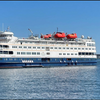Golar Bullish on LNG Shipping
Supported by low LNG prices, the LNG spot and short term market continues to represent an ever increasing share of global LNG trade, said Golar LNG, a liquefied natural gas shipping company registered in Bermuda.
"Continued strong growth in LNG production around the world and associated lower pricing together with customer’s increased focus on their ESG responsibility is also accelerating their appetite to switch from burning coal, fuel oil and diesel to cheaper and cleaner LNG," Iain Ross, CEO, Golar LNG, said.
Dominated by US projects, 114mtpa of new liquefaction capacity is slated to come on stream between 2020 and 2025. Based on current trading patterns the LNG order book of 109 vessels will not be sufficient to carry this.
Newbuild orders have slowed and the earliest delivery slot for a vessel ordered today is 2H 2022. With all of its 10 carriers recently dry docked, the Cool Pool will have uninterrupted exposure to this market. Golar expects shipping to be a positive earnings contributor from 4Q 2019 throughout 2020.
The third quarter began with LNG trading at multi-year low prices, at times below $4.00/mmbtu. A subdued commodity price and the continued absence of arbitrage opportunities kept a lid on spot shipping rates, which started the quarter at around $55kpd for a TFDE vessel.
New liquefaction facilities continue to deliver. Cameron T1, Prelude, Freeport T1, Corpus Christi T2 and Elba Island have all commenced production and new liquefaction is expected to start up and ramp up at the fastest pace on record over the course of 2020.
Ample new supply together with China's efforts to smooth its demand profile mean that Asian LNG prices have not however enjoyed their customary winter boost and the LNG arbitrage window has remained closed.
Much of this new US volume has therefore ended up in Europe. Despite lower upward pressure on ton mile demand, the structural shortage of vessels has arrived.
Charterers are increasingly keen to sign 1 year+ charters removing more vessels from the market and adding to upward pressure on spot rates. Owners are increasingly requesting offers rather than offering ships to charterers as a result.















